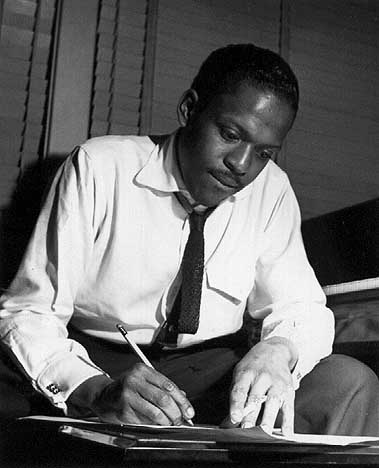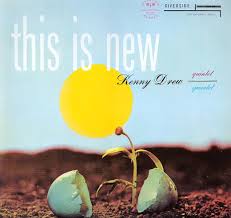Carol – Kenny Drew, Sr.
A dramatic ballad with plenty of Kenny's classic harmonic sophistication. Second parts are available for the quintet arrangement on the recording.
- Recording: Kenny Drew - This Is New
- Recorded on: March 28, 1957
- Label: Riverside (RLP 12-236)
- Concert Key: F
- Vocal Range: , to
- Style: Ballad
- Trumpet - Donald Byrd
- Tenor Sax - Hank Mobley
- Piano - Kenny Drew
- Bass - Wilbur Ware
- Drums - Wilbert Granville T. Hogan
Video
- Description
- Historical Notes
- Solos
- Piano Corner
- Bass Corner
- Drum Corner
- Guitar Corner
- Inside & Beyond
- Minus You
Despite its slow tempo, this song is striking in its bold and dramatic melodic structure as well as its many unexpected harmonic twists. The A section's general melodic shape is a descent of over an octave, though it is often broken up; similarly, the bridge melody ascends again to connect with the C (third A) section. The changes also fall and rise with the melody, whose starting note is the tonic F.
The starting chord, Bm7♭5, seems to imply a smoothly descending series of II-V7s to F, but this series takes six instead of the expected four measures and resolves to Am(maj7) and Gm(maj7) along the way. The first A section melody's descent does not reach the lower octave tonic, instead rising again in the sixth measure and landing on C with a very intricate harmonic resolution. The eighth measure has a superimposed B triad (with F and A below, forming B7/F) moves up a half step to form an upper-extension C triad for Fmaj9. The second A section ends more simply, with the melody descending not to the lower F but to E—with a 4-3 suspension on the tonic chord, resulting in a rare maj7sus tonality.
The bridge is no less sophisticated. The melody rises, again from F to E, growing out of a D♭ major tonality that suddenly becomes D major. In the fifth and sixth measures of the bridge, minor 7th chords chromatically ascend from D toward G major, followed by G minor in the last measure to resolve back to an F tonality. Two very unexpected but effective harmonic transitions occur in the bridge. Between the second and third measures, E diminished is followed by Em7♭5—the one difference between these chords is D♭ versus D, the tonics of the two implied tonalities in this transition. Equally unusual is the resolution into the seventh measure of the bridge, B♭7 to Gmaj7.
The C section is the same as the second A section, but on the out melody there is a coda that "tags" the last measure. This leads to yet another unexpected harmonic trick: a final II-V7 a half step up, landing in G♭ major—not with F in the melody either! Instead, this coda melody recycles the half-step approach that had previously occurred at the end of the first A section.
This recording features a two-horn arrangement, with the tenor sax 2nd part mostly providing longer notes that outline the changes. The horns are in octaves in a few places near the ends of the A and C sections. The piano takes the melody on the bridge; this melody on the lead sheet is shown with the rhythms that Kenny plays on the recording.
The starting chord, Bm7♭5, seems to imply a smoothly descending series of II-V7s to F, but this series takes six instead of the expected four measures and resolves to Am(maj7) and Gm(maj7) along the way. The first A section melody's descent does not reach the lower octave tonic, instead rising again in the sixth measure and landing on C with a very intricate harmonic resolution. The eighth measure has a superimposed B triad (with F and A below, forming B7/F) moves up a half step to form an upper-extension C triad for Fmaj9. The second A section ends more simply, with the melody descending not to the lower F but to E—with a 4-3 suspension on the tonic chord, resulting in a rare maj7sus tonality.
The bridge is no less sophisticated. The melody rises, again from F to E, growing out of a D♭ major tonality that suddenly becomes D major. In the fifth and sixth measures of the bridge, minor 7th chords chromatically ascend from D toward G major, followed by G minor in the last measure to resolve back to an F tonality. Two very unexpected but effective harmonic transitions occur in the bridge. Between the second and third measures, E diminished is followed by Em7♭5—the one difference between these chords is D♭ versus D, the tonics of the two implied tonalities in this transition. Equally unusual is the resolution into the seventh measure of the bridge, B♭7 to Gmaj7.
The C section is the same as the second A section, but on the out melody there is a coda that "tags" the last measure. This leads to yet another unexpected harmonic trick: a final II-V7 a half step up, landing in G♭ major—not with F in the melody either! Instead, this coda melody recycles the half-step approach that had previously occurred at the end of the first A section.
This recording features a two-horn arrangement, with the tenor sax 2nd part mostly providing longer notes that outline the changes. The horns are in octaves in a few places near the ends of the A and C sections. The piano takes the melody on the bridge; this melody on the lead sheet is shown with the rhythms that Kenny plays on the recording.
Carol is the only Drew original on "This Is New," the second of his four albums as a leader for the Riverside label. The occasional Messengers horn section of Hank Mobley and Donald Byrd first recorded together on Donald's 1955 Transition album "Byrd's Eye View." Less than a month after this Drew session, Byrd, Mobley, and bassist Wilbur Ware played together on a Mobley-led Blue Note session issued with the title "Hank," with pianist Bobby Timmons, drummer Philly Joe Jones and alto saxophonist John Jenkins. Wilbert Granville T. Hogan, the forgotten drummer with the unforgettable name, did not otherwise record with Drew, Mobley or Ware; he did however play alongside Donald Byrd in Lionel Hampton's big band in 1959. Another recording with Hogan is Kenny Dorham's "2 Horns, 2 Rhythm" album with Ernie Henry and bassist Eddie Matthias, which contains one of the many versions of Lotus Blossom.
Related Songs
Email Send Carol to a friend
Send this page to a friend via email. Add your name or email in the first field. In the second, add one or more email addresses, separated by a comma.

Kenny Drew, Sr.
August 28, 1928 – August 4, 1993
Kenny Drew was born in New York City. He studied classical piano but soon turned to jazz. His recording career started in 1950 at age 22, first with Howard McGhee for Blue Note, then Sonny Stitt for Prestige. These two 1950 recordings plus a surviving radio broadcast with Charlie Parker (December 8, 1950) put him in the company of jazz greats J.J Johnson, Max Roach and Art Blakey. Read more...
There was a problem.
...

